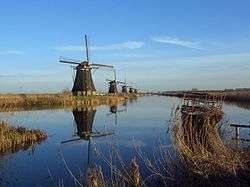Waterlogging (agriculture)

Waterlogging refers to the saturation of soil with water. Soil may be regarded as waterlogged when the water table of the groundwater is too high to conveniently permit an anticipated activity, like agriculture.
In agriculture, various crops need air (specifically, oxygen) to a greater or lesser depth in the soil. Waterlogging of the soil stops air getting in. How near the water table must be to the surface for the ground to be classed as waterlogged, varies with the purpose in view. A crop's demand for freedom from waterlogging may vary between seasons of the year, as with the growing of rice (Oryza sativa).
In irrigated agricultural land, waterlogging is often accompanied by soil salinity as waterlogged soils prevent leaching of the salts imported by the irrigation water.
From a gardening point of view, waterlogging is the process whereby the soil blocks off all water and is so hard it stops air getting in and it stops oxygen from getting in.
See also
- Drainage
- Drainage research
- Drainage system (agriculture)
- Effects of weather on sport
- Environmental impact of irrigation
- Polder
- Soil salinity control
- Watertable control
External links
- http://www.waterlog.info gives free downloads of software and articles on land drainage for waterlogging control.